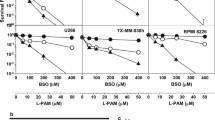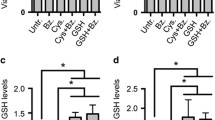Abstract
Diallyl disulfide (DADS), one of the main components of garlic, is well known to have anticancer effects on multiple cancers. However, its efficacy in treating multiple myeloma (MM) is yet to be determined. We explored the effects of DADS on MM cells and investigated the synergistic effects of DADS when combined with five anti-MM drugs, including melphalan, bortezomib, carfilzomib, doxorubicin, and lenalidomide. We analyzed cell viability, cell apoptosis, and DNA damage to determine the efficacy of DADS and the drug combinations. Our findings revealed that DADS induces apoptosis in MM cells through the mitochondria-dependent pathway and increases the levels of γ-H2AX, a DNA damage marker. Combination index (CI) measurements indicated that the combination of DADS with melphalan has a significant synergistic effect on MM cells. This was further confirmed by the increases in apoptotic cells and DNA damage in MM cells treated with the two drug combinations compared with those cells treated with a single drug alone. The synergy between DADS and melphalan was also observed in primary MM cells. Furthermore, mechanistic investigations showed that DADS decreases reduced glutathione (GSH) levels and increases reactive oxygen species (ROS) production in MM cells. The addition of GSH is effective in neutralizing DADS cytotoxicity and inhibiting the synergy between DADS and melphalan in MM cells. Taken together, our study highlights the effectiveness of DADS in treating MM cells and the promising therapeutic potential of combining DADS and melphalan for MM treatment.




Similar content being viewed by others
Data availability
The data that support the findings of this study are available from the corresponding author upon reasonable request.
References
Palumbo A, Anderson K (2011) Multiple myeloma. N Engl J Med 364:1046–1060
Elbezanti WO, Challagundla KB, Jonnalagadda SC et al (2023) Past, present, and a glance into the future of multiple myeloma treatment. Pharmaceuticals (Basel) 16(3):415
Mateos MV, Dimopoulos MA, Cavo M et al (2018) Daratumumab plus bortezomib, melphalan, and prednisone for untreated myeloma. N Engl J Med 378:518–528
Rajkumar SV (2022) Multiple myeloma: 2022 update on diagnosis, risk stratification, and management. Am J Hematol 97:1086–1107
Rajkumar SV, Kumar S (2020) Multiple myeloma current treatment algorithms. Blood Cancer J 10(9):94
Giralt S (2010) A TAD better for myeloma therapy? Blood 115:1109–1110
Gardeney H, Bobin A, Gruchet C et al (2020) Three drug combinations in the treatment of fit elderly multiple myeloma patients. J Clin Med 9:3554
Bazarbachi AH, Al Hamed R, Malard F et al (2019) Relapsed refractory multiple myeloma: a comprehensive overview. Leukemia 33:2343–2357
Rauf A, Abu-Izneid T, Thiruvengadam M et al (2022) Garlic (allium sativum L.): its chemistry, nutritional composition, toxicity, and anticancer properties. Curr Top Med Chem 22:957–972
Mitra S, Das R, Emran TB et al (2022) Diallyl disulfide: a bioactive garlic compound with anticancer potential. Front Pharmacol 13:943967
Sundaram SG, Milner JA (1996) Diallyl disulfide induces apoptosis of human colon tumor cells. Carcinogenesis 17:669–673
Kim HJ, Kang S, Kim DY et al (2019) Diallyl disulfide (DADS) boosts TRAIL-Mediated apoptosis in colorectal cancer cells by inhibiting Bcl-2. Food Chem Toxicol 125:354–360
Ling H, Ji X, Lei Y et al (2020) Diallyl disulfide induces downregulation and inactivation of cofilin 1 differentiation via the Rac1/ROCK1/LIMK1 pathway in leukemia cells. Int J Oncol 56:772–782
Yin X, Zhang R, Feng C, Zhang J, Liu D, Xu K, Wang X, Zhang S, Li Z, Liu X, Ma H (2014) Diallyl disulfide induces G2/M arrest and promotes apoptosis through the p53/p21 and MEK-ERK pathways in human esophageal squamous cell carcinoma. Oncol Rep 32:1748–1756
Xia L, Lin J, Su J et al (2019) Diallyl disulfide inhibits colon cancer metastasis by suppressing Rac1-mediated epithelial-mesenchymal transition. Onco Targets Ther 12:5713–5728
Huang J, Yang B, Xiang T et al (2015) Diallyl disulfide inhibits growth and metastatic potential of human triple-negative breast cancer cells through inactivation of the β-catenin signaling pathway. Mol Nutr Food Res 59:1063–1075
Su B, Su J, Zeng Y et al (2018) Diallyl disulfide inhibits TGF-β1-induced upregulation of Rac1 and β-catenin in epithelial-mesenchymal transition and tumor growth of gastric cancer. Oncol Rep 39:2797–2806
Li Y, Wang Z, Li J, Sang X (2019) Diallyl disulfide suppresses FOXM1-mediated proliferation and invasion in osteosarcoma by upregulating miR-134. J Cell Biochem 120:7286–7296
Zhang XN, Zhao N, Guo FF et al (2022) Diallyl disulfide suppresses the lipopolysaccharide-driven inflammatory response of macrophages by activating the Nrf2 pathway. Food Chem Toxicol 159:112760
Yi L, Su Q (2013) Molecular mechanisms for the anti-cancer effects of diallyl disulfide. Food Chem Toxicol 57:362–370
Malla R, Marni R, Chakraborty A, Kamal MA (2022) Diallyl disulfide and diallyl trisulfide in garlic as novel therapeutic agents to overcome drug resistance in breast cancer. J Pharm Anal 12:221–231
Hui T, Yiling J, Guangqun C et al (2023) Diallyl disulfide downregulating RhoGDI2 induces differentiation and inhibit invasion via the Rac1/Pak1/LIMK1 pathway in human leukemia HL-60 cells. Environ Toxicol 38:1063–1077
Machado ART, Tuttis K, Santos PWDS et al (2022) Diallyl disulfide induces chemosensitization to sorafenib, autophagy, and cell cycle arrest and inhibits invasion in hepatocellular carcinoma. Pharmaceutics 14:2582
Alrumaihi F, Khan MA, Babiker AY et al (2022) The effect of liposomal diallyl disulfide and oxaliplatin on proliferation of colorectal cancer cells: in vitro and in silico analysis. Pharmaceutics 14:236
Abdel-Hamid NM, Abass SA, Eldomany RA et al (2022) Dual regulating of mitochondrial fusion and Timp-3 by leflunomide and diallyl disulfide combination suppresses diethylnitrosamine-induced hepatocellular tumorigenesis in rats. Life Sci 294:120369
Verbrugge I, Johnstone RW, Smyth MJ (2010) SnapShot: extrinsic apoptosis pathways. Cell 143:1192-1192.e1192
Cui Q, Wang JQ, Assaraf YG et al (2018) Modulating ROS to overcome multidrug resistance in cancer. Drug Resist Updat 41:1–25
Nakamura H, Takada K (2021) Reactive oxygen species in cancer: current findings and future directions. Cancer Sci 112:3945–3952
Perillo B, Di Donato M, Pezone A et al (2020) ROS in cancer therapy: the bright side of the moon. Exp Mol Med 52:192–203
Srinivas US, Tan BWQ, Vellayappan BA, Jeyasekharan AD (2019) ROS and the DNA damage response in cancer. Redox Biol 25:101084
Yang JS, Chen GW, Hsia TC et al (2009) Diallyl disulfide induces apoptosis in human colon cancer cell line (COLO 205) through the induction of reactive oxygen species, endoplasmic reticulum stress, caspases casade and mitochondrial-dependent pathways. Food Chem Toxicol 47:171–179
Wu XJ, Kassie F, Mersch-Sundermann V (2005) The role of reactive oxygen species (ROS) production on diallyl disulfide (DADS) induced apoptosis and cell cycle arrest in human A549 lung carcinoma cells. Mutat Res 579:115–124
Saini V, Manral A, Arora R et al (2017) Novel synthetic analogs of diallyl disulfide triggers cell cycle arrest and apoptosis via ROS generation in MIA PaCa-2 cells. Pharmacol Rep 69:813–821
Lemar KM, Aon MA, Cortassa S et al (2007) Diallyl disulphide depletes glutathione in Candida albicans: oxidative stress-mediated cell death studied by two-photon microscopy. Yeast 24:695–706
Bansal A, Simon MC (2018) Glutathione metabolism in cancer progression and treatment resistance. J Cell Biol 217:2291–2298
Xia J, Xu H, Zhang X et al (2017) Multiple myeloma tumor cells are selectively killed by pharmacologically-dosed ascorbic acid. EBioMedicine 18:41–49
Gomez-Bougie P, Oliver L, Le Gouill S et al (2005) Melphalan-induced apoptosis in multiple myeloma cells is associated with a cleavage of Mcl-1 and Bim and a decrease in the Mcl-1/Bim complex. Oncogene 24:8076–8079
Galeone C, Pelucchi C, Levi F et al (2006) Onion and garlic use and human cancer. Am J Clin Nutr 84:1027–1032
Carneiro BA, El-Deiry WS (2020) Targeting apoptosis in cancer therapy. Nat Rev Clin Oncol 17:395–417
Lin YT, Yang JS, Lin SY et al (2008) Diallyl disulfide (DADS) induces apoptosis in human cervical cancer Ca Ski cells via reactive oxygen species and Ca2+-dependent mitochondria-dependent pathway. Anticancer Res 28:2791–2799
Nagaraj NS, Anilakumar KR, Singh OV (2010) Diallyl disulfide causes caspase-dependent apoptosis in human cancer cells through a Bax-triggered mitochondrial pathway. J Nutr Biochem 21:405–412
Di C, Sun C, Li H et al (2015) Diallyl disulfide enhances carbon ion beams-induced apoptotic cell death in cervical cancer cells through regulating Tap73 /ΔNp73. Cell Cycle 14:3725–3733
Filomeni G, Aquilano K, Rotilio G, Ciriolo MR (2005) Glutathione-related systems and modulation of extracellular signal-regulated kinases are involved in the resistance of AGS adenocarcinoma gastric cells to diallyl disulfide-induced apoptosis. Cancer Res 65:11735–11742
Kwon KB, Yoo SJ, Ryu DG et al (2002) Induction of apoptosis by diallyl disulfide through activation of caspase-3 in human leukemia HL-60 cells. Biochem Pharmacol 63:41–47
Dimopoulos MA, Souliotis VL, Anagnostopoulos A et al (2007) Melphalan-induced DNA damage in vitro as a predictor for clinical outcome in multiple myeloma. Haematologica 92:1505–1512
Falco P, Bringhen S, Avonto I et al (2007) Melphalan and its role in the management of patients with multiple myeloma. Expert Rev Anticancer Ther 7:945–957
Poczta A, Rogalska A, Marczak A (2021) Treatment of multiple myeloma and the role of melphalan in the era of modern therapies-current research and clinical approaches. J Clin Med 10:1841
Acknowledgements
The authors thank Professor Wen Zhou from Central South University School of Basic Medical Sciences for providing MM cell lines.
Funding
This work was supported by grants from the Natural Science Foundation of Hunan Province (2023JJ10036), PhD Scientific Research Start-up Fund of the University of South China (200XQD075), Scientific Research Project of Hunan Department of Education (22B0452), Hunan Provincial Innovation Foundation for Postgraduates (CX20220975), and National College Student Innovation and Entrepreneurship Training Program (210XCX536, 220XCX079, 220XCX254, 220XCX486).
Author information
Authors and Affiliations
Contributions
J.X., X.Z., and J.L. designed the research. W.H., J.S., Y.Z., F.H., and T.C. performed the experiments and analyzed the data. H.Z., W. T., Z.W., J.O., Z.T., J.H., and J.W. provided technical assistance. J.X. and X.Z. wrote and revised the manuscript. All authors read and approved the final manuscript.
Corresponding authors
Ethics declarations
Conflict of interest
The authors declare no competing interests.
Additional information
Publisher's Note
Springer Nature remains neutral with regard to jurisdictional claims in published maps and institutional affiliations.
Supplementary Information
Below is the link to the electronic supplementary material.
Rights and permissions
Springer Nature or its licensor (e.g. a society or other partner) holds exclusive rights to this article under a publishing agreement with the author(s) or other rightsholder(s); author self-archiving of the accepted manuscript version of this article is solely governed by the terms of such publishing agreement and applicable law.
About this article
Cite this article
Hu, W., Sun, J., Zhang, Y. et al. Diallyl disulfide synergizes with melphalan to increase apoptosis and DNA damage through elevation of reactive oxygen species in multiple myeloma cells. Ann Hematol 103, 1293–1303 (2024). https://doi.org/10.1007/s00277-023-05592-w
Received:
Accepted:
Published:
Issue Date:
DOI: https://doi.org/10.1007/s00277-023-05592-w




